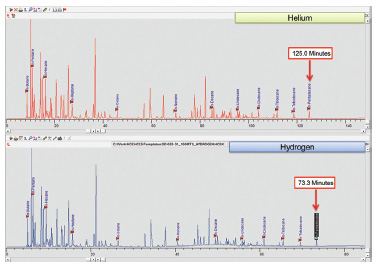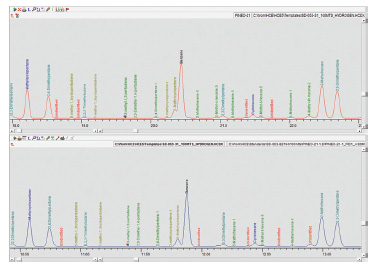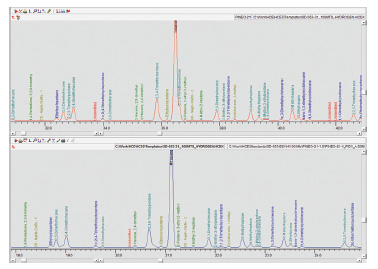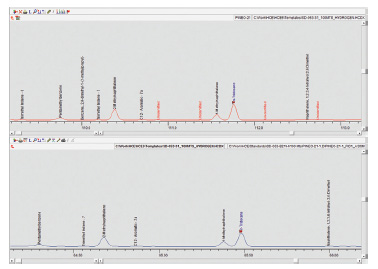In a variety of analytical laboratories in the petrochemical industry, single component analysis of hydrocarbons is often used to analyze and characterize individual components in a particular sample and to characterize mixtures of hydrocarbons ( DHA ) This separation technique. Multi-component analysis primarily detects the main components of gasoline: paraffin, olefins, naphthalenes and aromatics and combustible compounds with other carbon atoms ranging from 1 to 13 to determine the overall quality of the gasoline sample. The hydrogen generator equipment we used in this article is Peak Precision 500 Hydrogen Trace Generator. Analysis of the flammable components contained in gasoline is essential for the quality control of gasoline. Due to the complex composition of the gasoline sample, the characteristics of the components are very close, and in order to separate the components, a very long column (100 m) is usually required. When analyzing single components of hydrocarbons, a variety of methods are commonly used to separate these methods depending on the oven heating rate and column length used in these methods. These methods have their own advantages and disadvantages. Some methods are sensitive to low-boiling compounds and have high resolution; some methods have good resolution for compounds with large molecular weight and very late peaks. Due to the complex nature of the analytical methods, coupled with the use of very long columns, the gas chromatographic test time often exceeds two hours when helium is used as a carrier gas. However, the use of hydrogen as a carrier gas can greatly increase the speed of testing, because the high linear rate of hydrogen makes it very efficient when used as a carrier gas. This is undoubtedly a very attractive advantage for petroleum analysis laboratories, because the high throughput of the sample means an increase in the profitability of the laboratory. The use of hydrogen as a carrier gas can speed up the analysis of gas chromatography, coupled with the current tight supply of helium and rising prices, which means that the gas chromatograph laboratory that switches from helium to hydrogen as carrier gas will not only increase profitability. At the same time, the results of the analysis can meet industry standards. This application note states that when helium is used as a carrier gas, the results of the gasoline sample are analyzed according to ASTM standard test method D67291 and the hydrogen produced by BYC's Precision hydrogen generator Trace is not filtered to be used as a carrier gas. ASTM Standard Test Method D67291 Comparison of the results of the analysis of gasoline samples in Appendix X2. By contrast, we can see the reduction in the run time of the gas chromatograph, while the separation effect on the specific components remains unchanged. Results and discussion A single component analysis of gasoline for gasoline showed that the last eluting compound, n-pentadecane, was reduced from 125 minutes when hydrogen was used instead of helium as a carrier gas. 74 minutes. (As shown in Figure 1) Although the analysis time is different, the analysis of the main components in gasoline (paraffin, olefin, naphthalene and aromatic compounds) shows the main measurement when using hydrogen and helium as carrier gas. The difference in component content is not significant. Although the use of hydrogen as a carrier gas requires a higher gas flow rate, in most cases the separation of the components of the mixture is still very good, and even at some point, the separation effect is improved. The separation and detection of 1-methylcyclopentene and benzene are strictly regulated in the analysis of gasoline samples, because the analysis of benzene fragments is very important. When hydrogen is used as a carrier gas, although the elution time of the organic substance becomes shorter, the separation effect of the organic matter by gas chromatography is improved. (As shown in Fig. 2) The separation of toluene and 2,3,3-trimethylpentane can be achieved when helium is used as a carrier gas. When hydrogen is used as a carrier gas, both of these substances simultaneously peak ( As shown in Figure 3) When using hydrogen as a carrier gas, the method should be improved if the two substances are to be separated. When using hydrogen or helium as a carrier gas, the separation of tridecane and 1-methylnaphthalene by gas chromatography is very good and comparable. (As shown in Figure 4) The single-component analysis of hydrocarbons shows that when using hydrogen as a carrier gas, the analysis of gasoline samples according to the ASTM standard method D6729 Appendix X2 can greatly reduce the analysis time and, at the same time, the specific key components. The separation effect and resolution are still ideal. The ASTM standard test method specified in Table 1 can be used to determine the content of a single component of combustibles in engine fuel with the assistance of a high-resolution gas chromatograph equipped with a 100-meter capillary column. (ASTM International 2002) Table 2 Quantitative analysis and results of main components in gasoline Fig.1 Gas chromatogram of hydrocarbon single component analysis of gasoline samples when helium and hydrogen are used as carrier gases respectively Fig. 2 Comparison of the separation effect of 1-methylcyclopentene and benzene when hydrogen and helium are used as carrier gases respectively Fig. 3 Comparison of the separation effect of p-toluene and 2,3,3-trimethylpentane when using hydrogen and helium as carrier gases respectively Fig. 4 Comparison of the separation effect between tridecane and 1-methylnaphthalene when hydrogen and helium are used as carrier gases respectively reference 1. The specified D6729-01 standard test method requires a gas chromatograph equipped with a high resolution of 100 meters long capillary column to determine the single component of combustibles in the engine fuel. ASTM International 2002. 2. Specify D6729-01 Appendix X2 , the analysis data of hydrocarbons when hydrogen is used as the carrier gas. ASTM International 2004
• Rapid-screening within 10 minutes. COVID-19 Home Testing Kits NINGBO AUTRENDS INTERNATIONAL TRADE CO., LTD , https://www.metests.com





• High detection efficiency: simultaneous monitoring of IgM and IgG.
• Detection without any testing equipments .
• Easy to operate, and is compatible with serum/ plasma.
• Room-temperature storage.